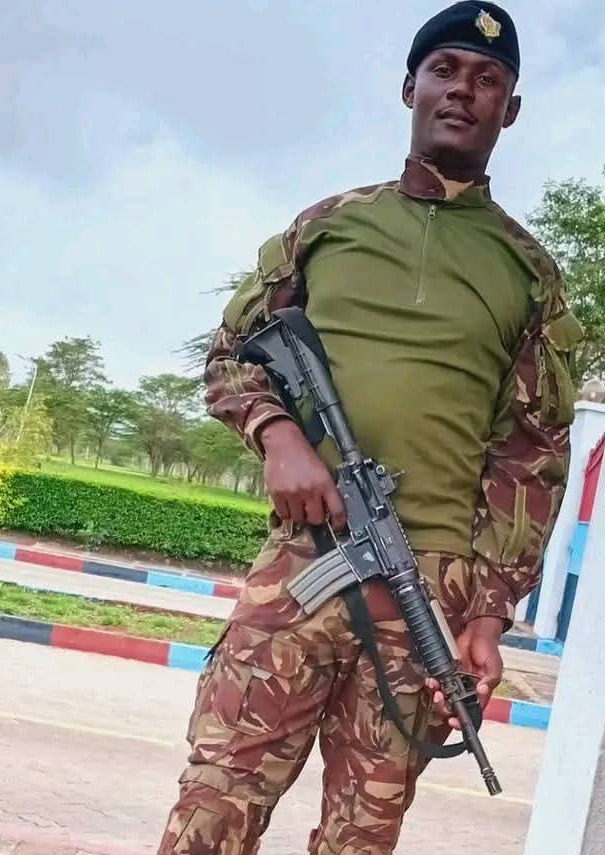A man identified as Wilington Kimtai Kipyegon was arrested on April 20, 2025, for impersonating a Kenya Defence Forces (KDF) officer and trespassing at the highly secure Embakasi Garrison in Nairobi. The arrest has raised serious concerns about security protocols within Kenya’s military facilities, as Kipyegon reportedly accessed multiple garrisons, lived among soldiers, and handled military equipment undetected for an extended period.
Kipyegon, who has no confirmed military background, was apprehended after authorities discovered he was in possession of a fake military identification card, a jungle uniform, and berets bearing the 27KR logo, associated with the Kenya Army’s 27th Battalion. He was detained at Kilimani Police Station and handed over to the Anti-Terrorism Police Unit (ATPU) for interrogation. The investigation aims to uncover his motives, potential accomplices, and how he managed to evade detection across several military sites.
According to reports, Kipyegon had been living within Embakasi Barracks, hosted by officers Kibet and Letulol in Runda single line room number 19. He allegedly obtained his military uniform from a former soldier named Chacha, who was dismissed from service years ago. This revelation has sparked questions about the control and disposal of military equipment, as unauthorized access to such items poses significant security risks.
Kipyegon’s activities extended beyond Embakasi Garrison. He reportedly gained access to other military facilities, including Kahawa Garrison, Moi Air Base, Kenyatta Barracks, and sites in Mombasa. He even attended KDF Day celebrations in Thika, where he wore a full military uniform and posed for photographs with engineers’ personnel. In one particularly alarming incident, Kipyegon was allowed to handle a rifle by an officer, with which he took a photo, highlighting the level of trust he gained from unsuspecting personnel.
The suspect’s prior legal troubles add complexity to the case. In 2021, Kipyegon was arrested by Ruai Police Station officers and charged with possessing a fake firearm. He was released on bail but absconded in 2022, resulting in an outstanding arrest warrant. On April 23, 2025, he was arraigned in Makadara Law Courts to face charges related to both the impersonation and his earlier case. Authorities noted that his history of evading justice prevented his release on cash bail.
The ATPU is investigating whether Kipyegon acted alone or was part of a larger scheme. Some reports suggest he may have been working as a security guard for two influential civilians with ties to the military, though this has not been officially confirmed. The involvement of anti-terrorism officers indicates that authorities are exploring potential links to broader security threats, though no evidence of terrorism or espionage has been publicly disclosed.
Kenyans have expressed shock and outrage over the incident, with many taking to social media to question how a civilian could infiltrate secure military facilities so easily. Posts on X describe Kipyegon as a “fake soldier” and compare his actions to scenes from spy movies. Others have called for accountability, urging the KDF to strengthen security measures to prevent similar breaches. One user noted that poor trigger discipline in a photo Kipyegon took with a rifle may have aided his identification and apprehension.
The KDF issued a statement acknowledging the arrest, stating, “The matter is currently under investigation by the relevant authorities. As investigations are still in their early stages, it would be premature to draw any conclusions or provide substantive details at this time.” Kilimani Sub-County Police Commander Patricia Yegon and military spokesperson Brigadier Paul Njuguna declined to comment further, citing the ongoing investigation.
This incident is not the first of its kind in Kenya. In 2019, a sacked KDF officer, Hassan Ali Wario, was arrested for posing as a Kenya Navy officer. In 2021, three individuals were detained for conning Kenyans with fake KDF job offers, one of whom was found wearing a senior officer’s uniform. These cases highlight a recurring issue of impersonation and misuse of military credentials, pointing to the need for systemic reforms.
The breach has prompted calls for a review of military security protocols, including stricter ID verification, better control over uniforms, and enhanced training for personnel to identify suspicious behavior. Authorities are also examining how dismissed soldiers’ access to military resources can be curtailed to prevent future misuse.
As the investigation continues, Kipyegon remains in custody, facing charges of impersonation, trespassing, and potentially more, depending on the findings. The case serves as a stark reminder of the vulnerabilities within even the most secure institutions and the importance of robust oversight to safeguard national security.

